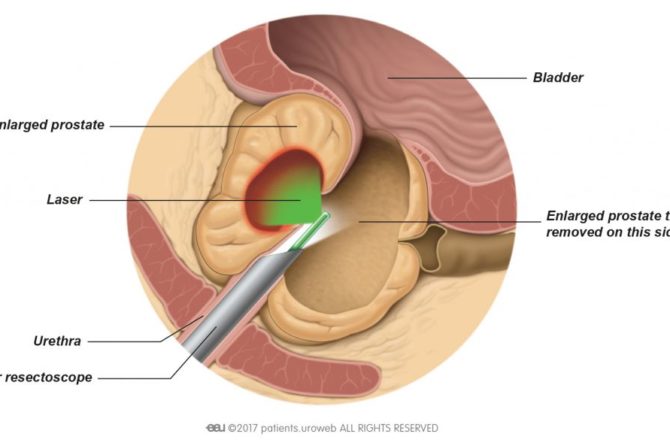
LASER PROSTATECTOMY: THE “BLOODLESS” PROSTATE SURGERY
Gone are the days when a man’s body needed to be surgically cut open to do prostate surgery. Now, it is the era of “bloodless” surgery for prostate.
A prostatectomy is the surgical removal of all or part of the prostate gland.
Abnormalities of the prostate, such as a tumour, or if the gland itself becomes enlarged for any reason, can restrict the normal flow of urine along the urethra.
This method (Laser Prostatectomy) utilizes laser energy to remove tissue.
With laser prostate surgery a fiber optic cable pushed through the urethra is used to transmit lasers such as holmium-Nd:YAG high powered “red” or potassium titanyl phosphate(KTP) to vaporize the adenoma.
The specific advantages of utilizing laser energy rather than a traditional electrosurgical TURP is a decrease in the relative blood loss, elimination of the risk of TUR syndrome, the ability to treat larger glands, as well as treating patients who are actively being treated with anti-coagulation therapy for unrelated diagnoses.
Procedure
Before the procedure the bladder and urethra may be numbed (local anesthesia), body below the waist may be numbed (regional anesthesia), or the patient may be completely asleep (general anesthesia).
The procedure itself usually takes about 45 minutes. The doctor inserts a cystoscope (a thin, tubelike telescope) through the urethral opening in the penis and into the urethra.
The doctor can view the urethra and prostate, either through the cystoscope or on a video monitor. The laser is inserted through the cystoscope to the area of the prostate.
The laser is then used to destroy excess prostate tissue.
This treatment often causes swelling, so a catheter may be inserted temporarily into the urethra or directly into the bladder to help with bladder drain.
Related Services
-
Minimal Access Advanced Laparoscopic Surgery
Fibroids are a common uterine tumor affecting 20 to 25% women. Fibroid develops from benign transformation of a single smooth muscle cell. The growth of Myoma is dependent on many factors. Increased estrogen stimulation alone or together with growth hormone or human placental lactogen appears to be the major growth regulator of Fibroid.
-
Bloodless Medicine And Surgery
Safehands Medical Centre has extensive and proven experience in patient blood management and is actively involved in the provision of bloodless medicine and surgery(BMS)
